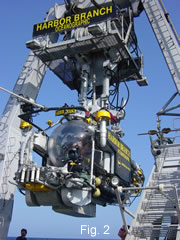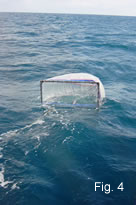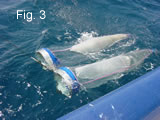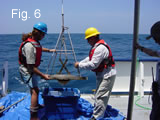page 1of 4
All photos credited to Project Oceanica unless noted
otherwise
In late July Dr. Leslie Sautter and I had the opportunity to join Chief
Scientist Dr. George Sedberry
from the S.C. Department of Natural
Resources in Islands in the Stream 2002. The purpose of this NOAA
Ocean Exploration expedition was to explore high-relief areas along
the continental shelf edge and upper slope along the eastern coast of
Florida to North Carolina within an area known as the South Atlantic
Bight. It was my first research expedition as a new graduate student
and it was an extraordinary experience. We spent 10 days aboard Harbor
Branch Oceanographic Institute’s Research Vessel the Seward
Johnson (Fig. 1). During this time we had the incredible opportunity
to examine bottom habitats with the use of Harbor Branch’s
We spent 10 days aboard Harbor
Branch Oceanographic Institute’s Research Vessel the Seward
Johnson (Fig. 1). During this time we had the incredible opportunity
to examine bottom habitats with the use of Harbor Branch’s  Johnson-Sea-Link
II submersible (Fig. 2). The submersible enabled us to collect
video and photographic images of shelf-edge reef habitats as well as
samples of sediment, rocks, and marine organisms. At each site we visited,
we deployed instruments from the deck of the ship to collect plankton
and bottom sediments,
and to measure the conductivity (to determine salinity), temperature
and density of the seawater. I participated in all sample
Johnson-Sea-Link
II submersible (Fig. 2). The submersible enabled us to collect
video and photographic images of shelf-edge reef habitats as well as
samples of sediment, rocks, and marine organisms. At each site we visited,
we deployed instruments from the deck of the ship to collect plankton
and bottom sediments,
and to measure the conductivity (to determine salinity), temperature
and density of the seawater. I participated in all sample  collection
collection ,
and learned how to process samples once they were brought aboard. We
used two different types of net tows to collect plankton, the Bongo
(Fig. 3) and Neuston (Fig. 4) nets. Their mesh sizes are different so
several size fractions of plankton can be collected. We even caught
a seahorse (Fig. 5) in the Bongo net, which we placed in the shipboard
aquarium. To collect bottom sediments we used a Young grab (Fig 6).
The material
,
and learned how to process samples once they were brought aboard. We
used two different types of net tows to collect plankton, the Bongo
(Fig. 3) and Neuston (Fig. 4) nets. Their mesh sizes are different so
several size fractions of plankton can be collected. We even caught
a seahorse (Fig. 5) in the Bongo net, which we placed in the shipboard
aquarium. To collect bottom sediments we used a Young grab (Fig 6).
The material  collected
will be analyzed for chemical contaminants, organic matter, and the
type of sediment (e.g., percentage of sand,silt and clay).
collected
will be analyzed for chemical contaminants, organic matter, and the
type of sediment (e.g., percentage of sand,silt and clay).


